Having gutted my surplus Megadrive II to make a lovely bag for my girlfriend, I was left with a still-functioning circuit board, with its cartridge slot and plugs still intact.
Like the resourceful fellows who use every part of the cow, I thought I should find some practical application for this device. When I discovered that it would run quite happily on a 9 volt battery, I began to think about ways to build a smaller, battery-powered console. Finding a tiny lcd television for only $99 made the next step obvious; build in a screen and controller, making something like an oversized Gameboy. I set out the various parts I would need...
Opening up the pocket TV revealed two separate circuit boards, which could be moved next to each other. I decided at this stage to keep things simple by integrating a genuine Sega controller into the device. A 9.6v NiMH battery pack, intended for remote-controlled cars, provided power. The Sega PCB would be mounted on the back side, with the cartridge slot facing the rear.
It was at this stage that I hit a snag, when soldering the video-in wires to the tv board, I damaged the encoder chip and the picture went extremely dark. Fixing this proved to be impossible, and I began to look for a new screen.
Unfortunately, the small pocket TVs that had just been on sale were no longer sold anywhere. It seems that they have been phased out in favour of portable DVDs and video phones, so I had to look further afield.
A stall at a Melbourne market eventually provided an inexpensive and much bigger screen, intended for automotive applications.
The box proudly advertises such features as "No Radiation. Not Gleaming" which should be a massive relief for all those motorists irradiated to death by gleaming CRT screens mounted in their dashboards...
This screen, being designed for use in a car, needed a greater amount of power than my last one, necessitating a 12 volt battery pack. I decided, for reasons of cost and simplicity, to go with a sealed lead-acid battery, which would provide a useful 2200 mAh capacity for only $25. The other deciding factor was that a single large battery would greatly simplify recharging, instead of having to design a custom charging solution for a 10-battery pack with rechargeable AAs.
I decided on a new configuration for my portable, with the battery sitting below the screen, and the controller now split, with the D-pad (directional controller) on one side and the three Hit buttons on the other side. I built a basic wooden mockup of this design.
The incredibly helpful GameSX.com provided me with wiring diagrams for the controller ports and AV plug on the Megadrive board, and I constructed a small PCB with 3 buttons and the special multiplexer chip needed to use them on the Sega.
I cut a square out of wood and painted it black for the D-pad. Four small pushbuttons sit under the pad, which is supported by a central bolt that is free to rock slightly in each direction.
I built a two-compartment case, with the Sega PCB mounted in the rear compartment. An opening in the cover lines up with the cartridge slot, and a smaller, square opening allows clearance for the power regulator heatsink.
The front compartment of the case holds the LCD, battery and controller boards, as well as various wiring for the power and reset switches.
To make the device look and feel more interesting than the plain MDF board I used to construct it, I covered the MDP in black vinyl, with a thin layer of foam underneath. The seams were all hand-sewn one night, and the edges stuck down with heavy-duty staples.
The Power switch and Reset button were placed on the top corners. The exposed screws sticking out above them serve as recharge contacts. The battery charger is connected by alligator clips to these contacts, and the power switch moved to the recharge position.
After connecting all of the electronics and finishing off the exterior, I had a working portable game device that I regularly use to play my collection of classic Megadrive cartridges. The LCD still has its tuner, and can be used to watch broadcast television when I don't feel like playing games.
Like the resourceful fellows who use every part of the cow, I thought I should find some practical application for this device. When I discovered that it would run quite happily on a 9 volt battery, I began to think about ways to build a smaller, battery-powered console. Finding a tiny lcd television for only $99 made the next step obvious; build in a screen and controller, making something like an oversized Gameboy. I set out the various parts I would need...
Opening up the pocket TV revealed two separate circuit boards, which could be moved next to each other. I decided at this stage to keep things simple by integrating a genuine Sega controller into the device. A 9.6v NiMH battery pack, intended for remote-controlled cars, provided power. The Sega PCB would be mounted on the back side, with the cartridge slot facing the rear.
It was at this stage that I hit a snag, when soldering the video-in wires to the tv board, I damaged the encoder chip and the picture went extremely dark. Fixing this proved to be impossible, and I began to look for a new screen.
Unfortunately, the small pocket TVs that had just been on sale were no longer sold anywhere. It seems that they have been phased out in favour of portable DVDs and video phones, so I had to look further afield.
A stall at a Melbourne market eventually provided an inexpensive and much bigger screen, intended for automotive applications.
The box proudly advertises such features as "No Radiation. Not Gleaming" which should be a massive relief for all those motorists irradiated to death by gleaming CRT screens mounted in their dashboards...
This screen, being designed for use in a car, needed a greater amount of power than my last one, necessitating a 12 volt battery pack. I decided, for reasons of cost and simplicity, to go with a sealed lead-acid battery, which would provide a useful 2200 mAh capacity for only $25. The other deciding factor was that a single large battery would greatly simplify recharging, instead of having to design a custom charging solution for a 10-battery pack with rechargeable AAs.
I decided on a new configuration for my portable, with the battery sitting below the screen, and the controller now split, with the D-pad (directional controller) on one side and the three Hit buttons on the other side. I built a basic wooden mockup of this design.
The incredibly helpful GameSX.com provided me with wiring diagrams for the controller ports and AV plug on the Megadrive board, and I constructed a small PCB with 3 buttons and the special multiplexer chip needed to use them on the Sega.
I cut a square out of wood and painted it black for the D-pad. Four small pushbuttons sit under the pad, which is supported by a central bolt that is free to rock slightly in each direction.
I built a two-compartment case, with the Sega PCB mounted in the rear compartment. An opening in the cover lines up with the cartridge slot, and a smaller, square opening allows clearance for the power regulator heatsink.
The front compartment of the case holds the LCD, battery and controller boards, as well as various wiring for the power and reset switches.
To make the device look and feel more interesting than the plain MDF board I used to construct it, I covered the MDP in black vinyl, with a thin layer of foam underneath. The seams were all hand-sewn one night, and the edges stuck down with heavy-duty staples.
The Power switch and Reset button were placed on the top corners. The exposed screws sticking out above them serve as recharge contacts. The battery charger is connected by alligator clips to these contacts, and the power switch moved to the recharge position.
After connecting all of the electronics and finishing off the exterior, I had a working portable game device that I regularly use to play my collection of classic Megadrive cartridges. The LCD still has its tuner, and can be used to watch broadcast television when I don't feel like playing games.
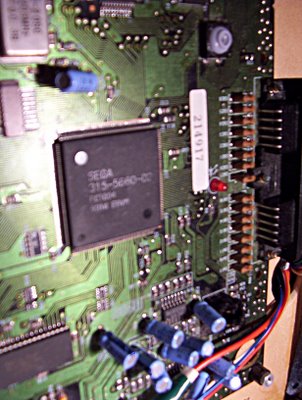


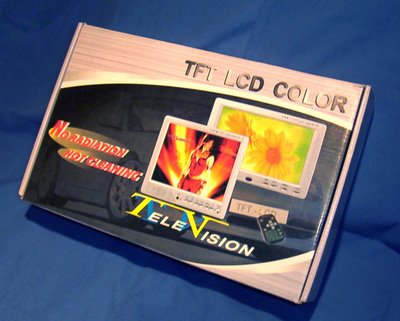
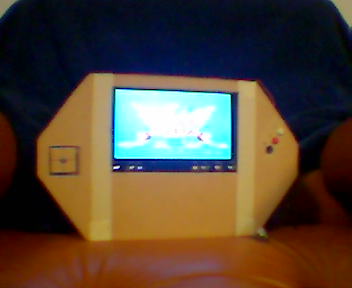

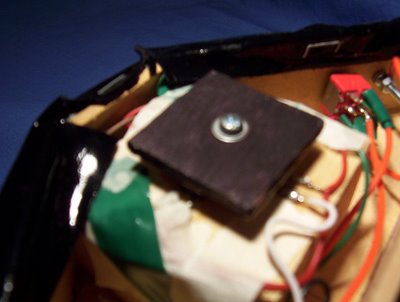
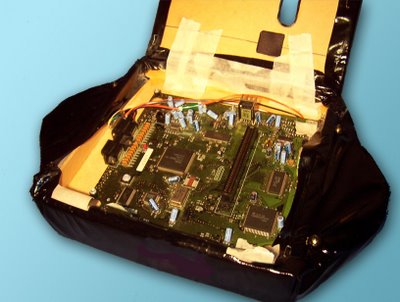
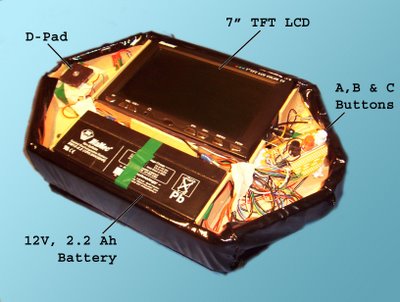
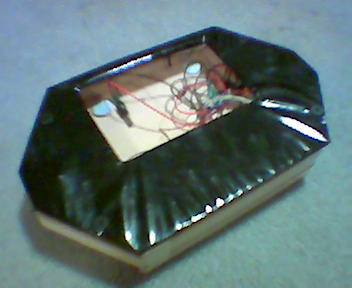
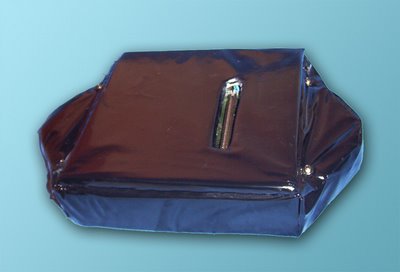
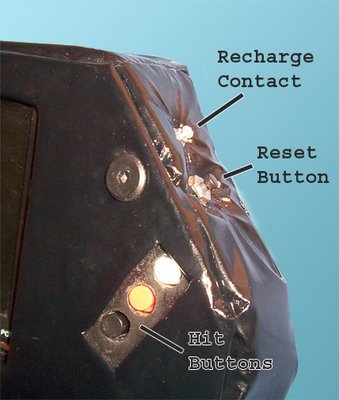

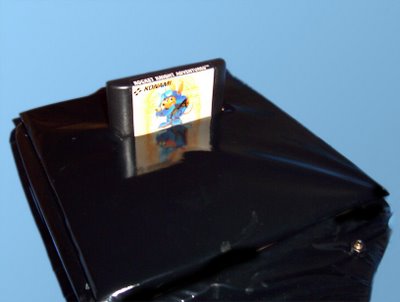
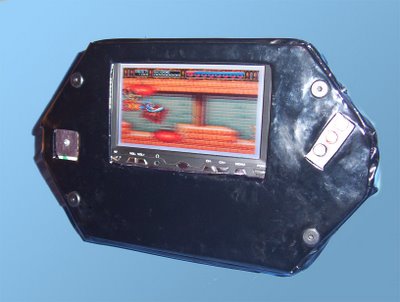
Comments